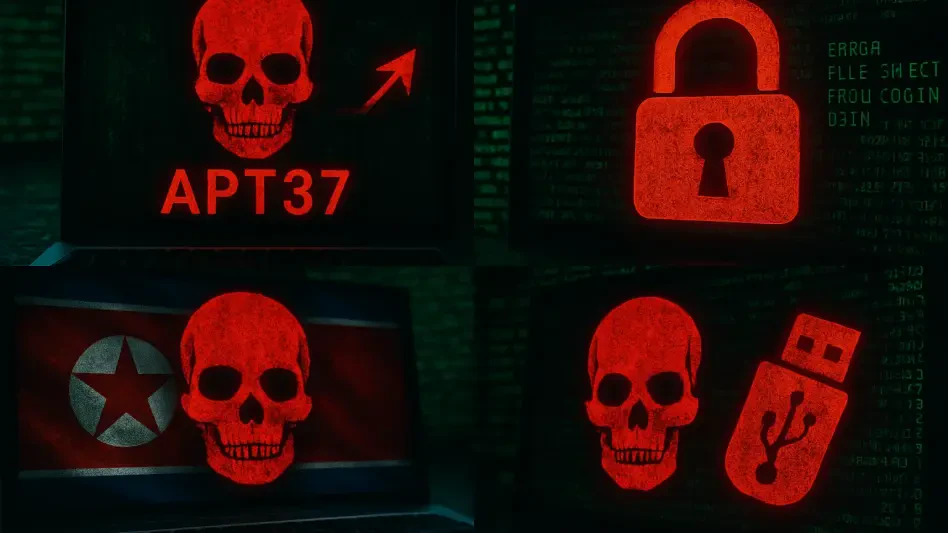In an era where cyber threats are becoming increasingly sophisticated, the North Korean-aligned group APT37, also known as ScarCruft or Velvet Chollima, stands out as a particularly adaptive adversary targeting Windows systems with alarming precision. Active for over a decade, this threat actor has historically focused on South Korean individuals connected to the North Korean regime and human rights activists, using espionage as a primary weapon. What sets APT37 apart in the current landscape is its adoption of modern programming languages like Rust and Python to craft advanced malware, paired with cutting-edge evasion tactics. This shift not only demonstrates a significant evolution in their technical capabilities but also poses new challenges for cybersecurity defenders worldwide. As state-sponsored groups continue to refine their approaches, understanding APT37’s latest strategies offers critical insights into the broader trends of cyber warfare and the urgent need for robust countermeasures to protect vulnerable systems and data.
Tactical Advancements in Malware Development
The evolution of APT37’s arsenal is marked by a deliberate move toward modern programming languages, showcasing a strategic intent to enhance both the effectiveness and stealth of their operations. A notable milestone is the introduction of Rustonotto, a lightweight Rust-based backdoor recently identified, which represents the group’s first foray into using Rust for targeting Windows systems. This tool facilitates basic command execution and data transmission to attacker-controlled servers, leveraging Rust’s performance and memory safety features to create a resilient threat. Alongside Rustonotto, APT37 continues to deploy Chinotto, a PowerShell backdoor in use for several years, and FadeStealer, a comprehensive surveillance tool active for at least a couple of years. Together, these components form a sophisticated malware ecosystem, centrally managed through a unified command-and-control server, reflecting a coordinated approach to cyber espionage that prioritizes persistence and adaptability in hostile digital environments.
Beyond the adoption of new languages, APT37’s development strategy reveals a nuanced understanding of blending old and new tools to maximize impact on targeted systems. While Rustonotto brings fresh capabilities with its efficient code structure, the continued reliance on established tools like Chinotto demonstrates a pragmatic balance between innovation and proven methods. FadeStealer, on the other hand, exemplifies the group’s focus on comprehensive data theft, with capabilities that extend far beyond simple backdoor functions to include detailed surveillance. This multi-pronged approach ensures that APT37 can tailor attacks to specific objectives, whether seeking immediate access or long-term monitoring of victims. The integration of Rust and Python into their toolkit also suggests an intent to exploit the strengths of these languages—Rust for low-level control and Python for flexible scripting—making their malware harder to detect and mitigate. Such advancements highlight the growing complexity of defending against state-sponsored threats in an ever-evolving cyber landscape.
Sophisticated Infection and Evasion Techniques
APT37’s infection methods have grown remarkably intricate, employing multi-layered chains that underscore their technical prowess in evading detection on Windows platforms. Initial compromise often begins with seemingly innocuous vectors like Windows shortcut files or Compiled HTML Help (CHM) files, which then trigger PowerShell-based payloads to infiltrate systems. A particularly innovative tactic is the use of Transactional NTFS (TxF) for stealthy code injection, a method that manipulates file system transactions to hide malicious activity. Additionally, a Python-based infection chain leverages Process Doppelgänging, where a custom loader decrypts and injects FadeStealer into legitimate processes such as calc.exe or svchost.exe. This technique creates transacted files and alters process contexts to execute payloads covertly, blending seamlessly with normal system operations and posing significant challenges to traditional security measures attempting to identify anomalous behavior.
Further illustrating APT37’s commitment to operational security, these evasion strategies are designed not just to infiltrate but to maintain long-term access without raising alarms. The use of Process Doppelgänging, for instance, allows malicious code to masquerade as legitimate system activity, significantly reducing the likelihood of detection by antivirus software or behavioral analysis tools. Meanwhile, the TxF approach exploits lesser-known features of Windows file systems, demonstrating a deep understanding of platform-specific vulnerabilities. These methods collectively ensure that once a system is compromised, APT37 can operate under the radar, extracting valuable data or executing commands with minimal risk of interruption. Such sophisticated tactics signal a shift in cyber threat dynamics, where attackers prioritize stealth over brute force, compelling defenders to rethink detection strategies and invest in advanced forensic capabilities to uncover hidden threats within complex system environments.
Surveillance and Data Exfiltration Capabilities
At the heart of APT37’s espionage efforts lies FadeStealer, a multi-threaded surveillance platform engineered for extensive data collection from compromised Windows systems. This tool operates with chilling efficiency, logging keystrokes continuously, capturing screenshots every 30 seconds, recording audio in 5-minute intervals, and monitoring USB devices and portable cameras on an hourly basis. The harvested data is meticulously organized into timestamped, password-protected RAR archives, using a hardcoded password for security, and then exfiltrated to command-and-control servers via HTTP POST requests. Structured directories under temporary system folders ensure systematic categorization of different data types, while archive naming conventions provide clear identifiers for regular surveillance versus targeted file collection. This level of organization reveals a methodical approach to espionage, aimed at maximizing the exploitation of victim information for strategic gain.
The implications of FadeStealer’s capabilities extend far beyond individual privacy breaches, posing severe risks to organizational and national security, especially for targets in South Korea. The ability to capture such a wide array of data—ranging from visual and auditory inputs to detailed user interactions—enables APT37 to construct comprehensive profiles of their victims, potentially influencing geopolitical strategies or compromising sensitive communications. The systematic exfiltration process, complete with encrypted archives, further complicates efforts to intercept or recover stolen data before it reaches hostile hands. For cybersecurity professionals, countering this threat requires not only detecting the initial infection but also disrupting the data transmission pipeline, a task made difficult by the covert nature of the communication protocols used. As APT37 refines these surveillance tools, the urgency to develop proactive defenses and international cooperation to address state-sponsored espionage grows ever more critical.
Looking Ahead: Strengthening Defenses Against Evolving Threats
Reflecting on APT37’s recent campaign, it’s evident that their integration of Rust and Python into malware development, coupled with advanced evasion tactics, marks a significant leap in their cyber warfare capabilities. The deployment of Rustonotto as a novel backdoor, alongside the persistent use of Chinotto and the invasive FadeStealer, highlights a strategic blend of innovation and reliability in targeting Windows systems. Their multi-layered infection chains and sophisticated data exfiltration methods demonstrate a clear intent to prioritize stealth and persistence, challenging even the most robust security frameworks of that time.
Moving forward, the cybersecurity community must adapt by investing in advanced threat detection tools capable of identifying subtle anomalies indicative of techniques like Process Doppelgänging or TxF exploitation. Collaboration between nations and organizations to share intelligence on APT37’s tactics can further bolster defenses, while regular updates to endpoint security solutions remain essential to counter new malware variants. By focusing on proactive measures and fostering a deeper understanding of state-sponsored threat actors, stakeholders can better anticipate and mitigate the risks posed by such evolving cyber threats, safeguarding critical systems and data from persistent adversaries.








